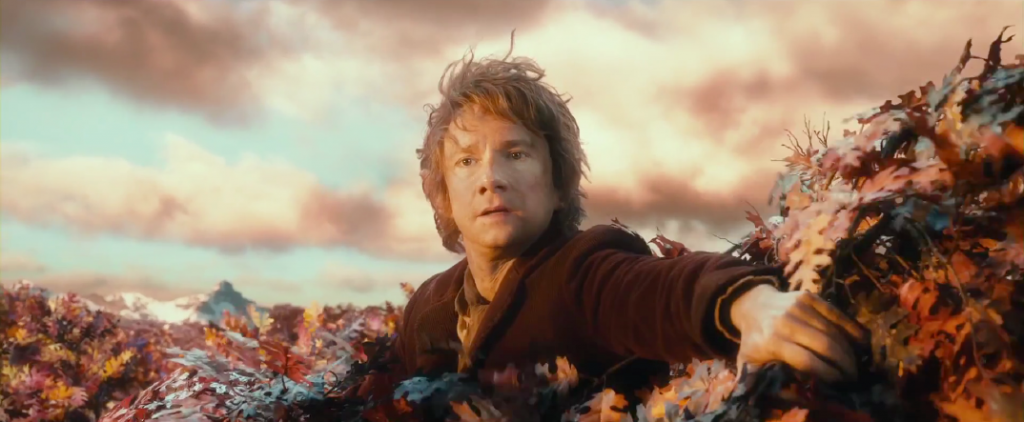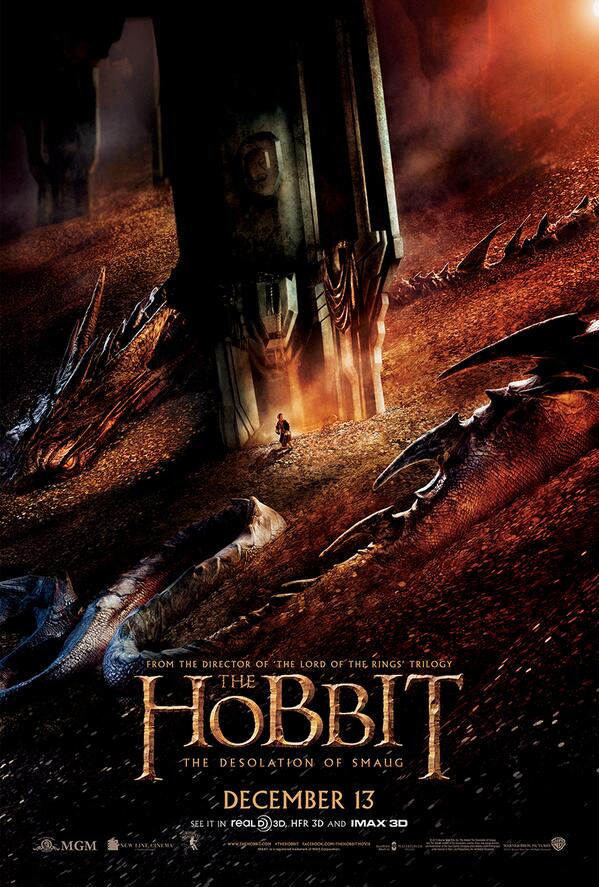
They say “better late than never”. I hope that’s true – because my review is coming a bit late. I love discussing cinema, but I’m not always very fast at collecting my thoughts. Many times, as on this occasion, I don’t even have a complete handle on the film until a second viewing. Also, I tend to write
on impulse – which means that something as organized as a film review takes me a little while to put together. I’m never able to discuss as much
as I would like to – so you can expect a few elements of the film to go uncovered. Otherwise, I could go on forever about each of these movies.
I also didn’t know how to approach this review. I had two very different reaction to this film – one as a Tolkien loyalist, another as a cinema lover. To the chagrin of many, I’m sure, I’ve chosen to focus on the latter. I’ve always viewed the books and PJ’s cinematic offerings as two completely separate things – and I think I must remain true to that. This is a film review of The Desolation of Smaug – which I unabashedly loved – and not a checklist of book vs. film differences. I look forward to such a discussion in the future, and hope you, dear readers, will indulge me in a different conversation at the present moment.
Note: The following review contains SPOILERS of moments throughout the film. You are officially warned.
The Hobbit: The Desolation of Smaug
Film Review by John Webster
In the opening scene of Peter Jackson’s The Desolation of Smaug, Thorin Oakenshield walks down the streets of Bree, turning slightly before entering the familiar Prancing Pony. Filmed in 48 frames per second 3D, we feel as though we are walking into the inn right along with him – and that is the quality that best sums up the second film in The Hobbit trilogy. We feel taken along for the ride, in what turns out to be a fun, action-packed 2 hours and 40 minutes.
Before that ride begins, however, we are treated to a splendid opening scene – one which cleverly echoes The Fellowship of the Ring (including an outrageously hilarious – and unsubtle – Peter Jackson cameo). In the scene, Gandalf the Grey arranges a meeting with Thorin before the beginning of the previous film. This scene wonderfully re-frames the story and sets up the importance of the prized jewel – the Arkenstone, as well as exactly why a burglar will be so essential to the success of the quest they are about to embark upon. What I really enjoyed about this scene was the aforementioned callback to FotR. Visually, it matches perfectly with the Bree scenes from that film – and even Gandalf looks rather reminiscent of his appearance in that film. It’s something about the way the costume designers have dressed Ian McKellen up in the wizard’s garb. He’s somewhat unkempt, with his hair not quite as groomed. I also think the scene is the perfect way in which to get the audience used to the effect of the High Frame Rate. In An Unexpected Journey, the prologue moved so fast that it made getting used to the more fluid movement somewhat disorienting. By comparison, this more relaxed scene allows the viewer to become more attuned to the life-like imagery offered by the format.
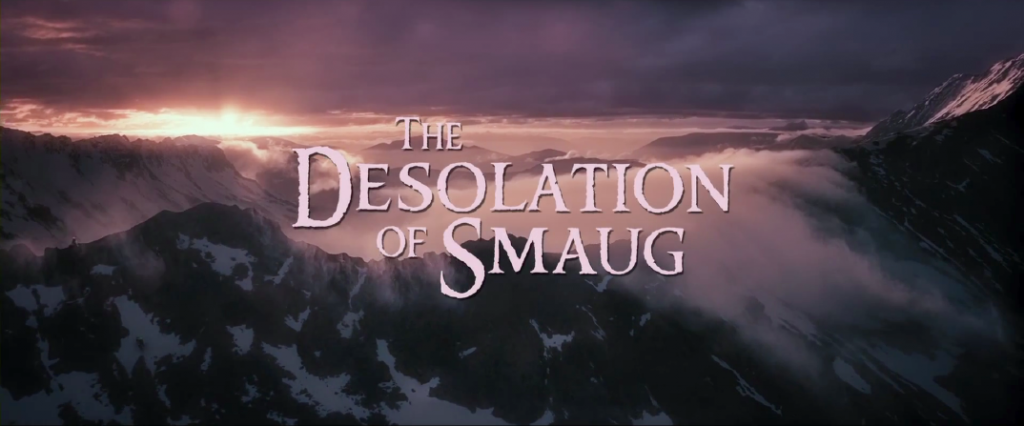 Following this prelude, we pick up with the events of the quest as seen in the first film. Bilbo, Gandalf and the dwarves are on the run from Azog the Defiler. By the time the title card appears on-screen, it’s plenty obvious that there’s a kinetic energy to
Following this prelude, we pick up with the events of the quest as seen in the first film. Bilbo, Gandalf and the dwarves are on the run from Azog the Defiler. By the time the title card appears on-screen, it’s plenty obvious that there’s a kinetic energy to
this latest chapter. By contrast, An Unexpected Journey had a more relaxed and leisurely pace in its first half – giving plenty of time to introduce character and plot, perhaps to a fault. The Desolation of Smaug, on the other hand, has a non-stop momentum that doesn’t let up.
After seeking refuge with the skin changer Beorn (a brief, but memorable, turn by Mikael Persbrandt), the company is on the run again. They reach the boarders of Mirkwood, and we – the audience – are treated to one of the most thrilling, and disturbing, moments of the film. I refer, of course, to Bilbo’s rescue of the dwarves from the spiders. After proving his mettle once again by freeing the others from their captivity – the film takes the opportunity to show the dangerous effect the Ring is having on our Mr. Baggins. After losing hold of it, Bilbo goes in search of the Ring, only to come face to face with one of the smaller spiders. The manner in which Bilbo dispatches the creature and reclaims his precious is frighteningly familiar. Despite the obvious danger Bilbo faces, the kill nonetheless calls one’s mind back to Smeagol’s brutal murdering of Deagol in The Return of the King. Bilbo is almost gleeful in his victory, claiming the Ring back as “Mine!”. What follows is one of Martin Freeman’s most brilliant moments in the film – a slow realization of – and horror at – what he’s just done. This event informs Bilbo’s character for the rest of the film – not only explaining his hesitation at using the Ring later on, but also setting up his fear of what awaits Thorin should he fall prey to the dragon sickness.
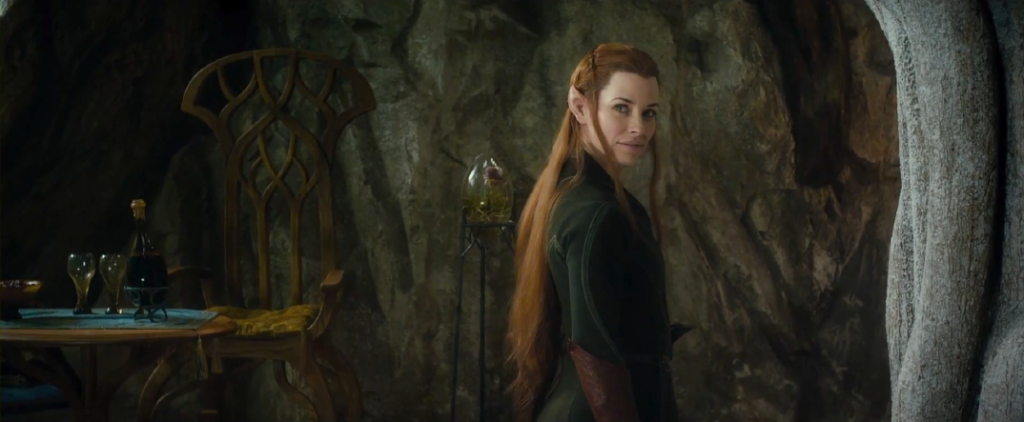 The rescue is soon aided by the Elves of Mirkwood, and we are granted our first glimpse of the new character Tauriel, played by Evangline Lilly. Controversy over a non-book character aside, Lilly delivers a magnificent performance – most notably during her conversation with Kili (Aidan Turner) discussing the “Feast
The rescue is soon aided by the Elves of Mirkwood, and we are granted our first glimpse of the new character Tauriel, played by Evangline Lilly. Controversy over a non-book character aside, Lilly delivers a magnificent performance – most notably during her conversation with Kili (Aidan Turner) discussing the “Feast
of Starlight”. If I have a complaint, it’s that I feel her character is slightly underdeveloped. It’s obvious that she has a curiosity
and concern about the outside world – but more screen-time is given to the bond she develops with the young dwarf. As a result, her subsequent departure from the Elven-wood seems to be brought on more by her concern for him than the reasons which she later implores Legolas to consider. This is an area that I hope will be fleshed out in the Extended Edition. Nonetheless, Lilly brings such fire to the role that you are prepared to follow her whatever her motivation. She is aided by Howard Shore’s fantastic new theme for Tauriel, which set my mind to many a swashbuckling adventure from cinema history.
I would be remiss if I didn’t discuss the much talked about barrel escape. The sequence is a tour-de-force, depending on your opinion of CGI and green screen effects. While much of the escape was also filmed in real locations and using practical effects – the newer technology is also on display in abundance here. But it all comes together magnificently. In 48 FPS, the sequence was spellbinding – practically a theme park ride (and I say that with great affection). But perhaps equally thrilling are the moments that precede it. As the dwarves sit in their cells, lamenting at their circumstances – Bilbo appears out of nowhere with the keys. The enthusiasm with which he is received warmed my heart so much. I loved the way Richard Armitage and Ken Stott played the moment. Thorin is almost completely lacking in surprise – he is all too aware that Bilbo has no intention of turning back and is willing to risk his life for the good of the Company. Balin, meanwhile, lights up at Bilbo’s appearance – immediately shouting “Bilbo!” and beaming with pride as his cell door is opened. If I had to pick a moment in which this film series captured my emotions and endeared me to these characters (and wiping away all desire for the safety blanket of Rings‘ characters and story), it would be this one. It’s one of the most magical moments in both films.
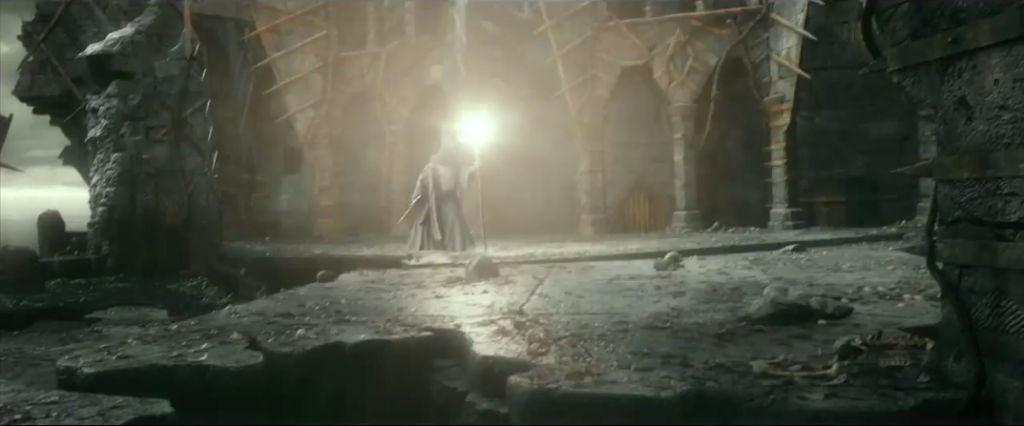 While the dwarves have been contending with the dangers of Mirkwood, Gandalf goes off in search of answers regarding the Morgul blade discovered by Radagast (Sylvester McCoy) in An Unexpected Journey. Gandalf’s journey in this film is an interesting one, albeit a bit lacking as well. The problem, I feel,
While the dwarves have been contending with the dangers of Mirkwood, Gandalf goes off in search of answers regarding the Morgul blade discovered by Radagast (Sylvester McCoy) in An Unexpected Journey. Gandalf’s journey in this film is an interesting one, albeit a bit lacking as well. The problem, I feel,
is that there is so little time devoted to it. There’s also a lack of tension involved, because the reemergence of Sauron is already laid out in the conversation between Gandalf and Radagast after the discovery at the Nazgul tombs. One wonders why the writers didn’t hold back on divulging the truth until the last confrontation of the film. The scenes at Dol Guldur are also too brief. I do think we’re in for a more fleshed out version of these sequences in the Extended Cut, but at present they come across as a bit too rushed. At the same time, however, seeing our beloved wizard go head to head with the Big Bad of Middle-earth is thrilling no matter how brief it is. In this reviewers humble opinion, it will be quite the sight when the White Council descents upon this dark fortress.
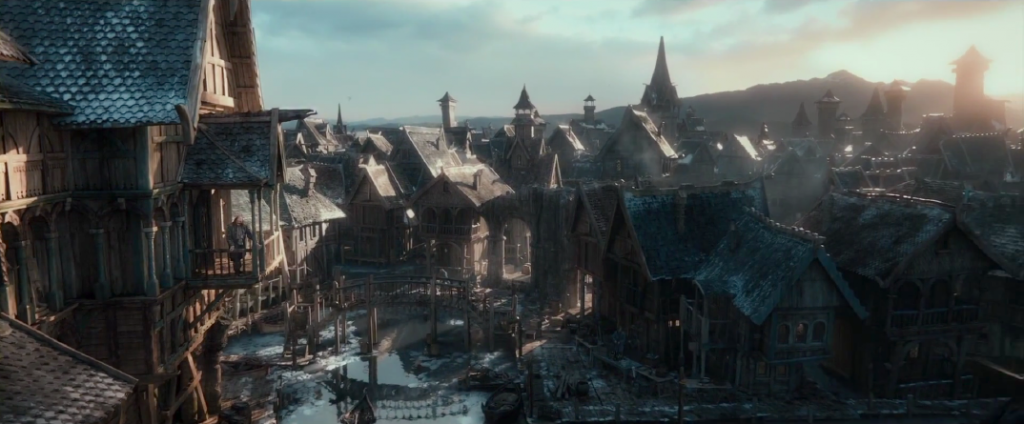 Returning to the exploits of Bilbo and the dwarves, we enter Laketown. PJ has created a wondrous new location on-screen
Returning to the exploits of Bilbo and the dwarves, we enter Laketown. PJ has created a wondrous new location on-screen
in Esgaroth – and I’m not sure it can be entirely appreciated in 24 FPS. Watching Bard’s barge enter into the town was unlike anything I’d yet seen. In HFR, you feel like you’re really sailing into this half-underwater colony. Many have spoken ill of 48 FPS 3D by saying that it feels like your watching a film set – but, in this case, I’d argue that’s exactly what’s so remarkable about it. So much work has gone into this particular set, and watching the film – it’s like you’re actually there, running along the decks of the once great town.
We’re treated to a trio of great new performances in this section of the film. We meet Bard, played by Luke Evans – who grounds this section of the film by embodying the better nature of the race of Men. He’s a man who just wants what is best for his family and fellow residents. Considering where the film leaves his story, one can’t help but feel that the real meat of his performance is yet to come in There and Back Again. We also get a glimpse at The Master of Laketown (Stephen Fry) and his servant Alfrid (Ryan Gage) – who are just utterly delightful in how corrupt they are. I was happy that these characters were not overplayed. They’re slimy and disreputable – but wonderfully portrayed, with just enough comedy thrown in.
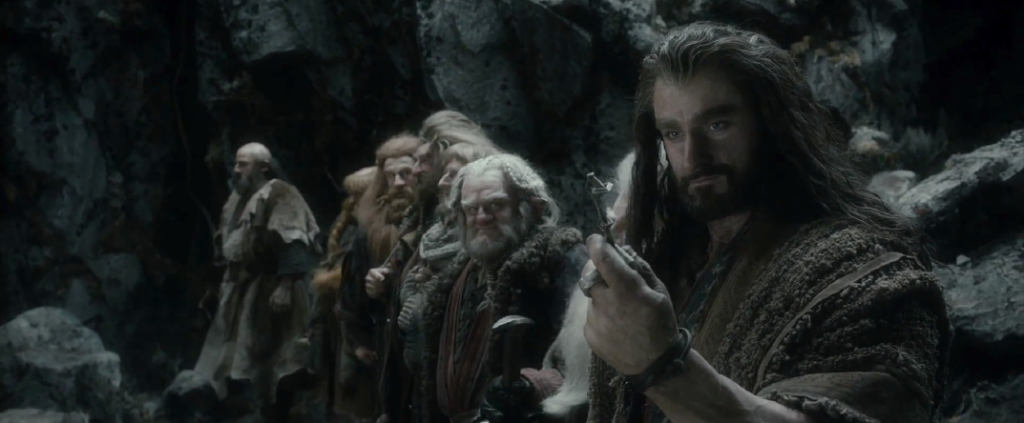 The company soon continues on to the Lonely Mountain – and the moment of truth presents itself as they await the appearance of the keyhole to the hidden entrance. If anyone desires to know my favorite performance of this film – it’s Richard Armitage, and this scene is the reason why. When the runes on the map prove to be somewhat deceptive, Armitage perfectly portrays Thorin’s complete and utter loss of hope. His determination fades bit by bit as the sun disappears, until he acknowledges defeat. He believed in his heart of hearts that this was going to work – “…the last light… of Durin’s Day will shine…upon…the keyhole. That’s what it says…” As the dwarves retreat from the mountainside, Freeman has one of his own best moments as Bilbo discovers the true meaning of the moon runes and eagerly calls the dwarves back. Upon entering Erebor, Armitage and Stott reach down and tug at your heartstrings.
The company soon continues on to the Lonely Mountain – and the moment of truth presents itself as they await the appearance of the keyhole to the hidden entrance. If anyone desires to know my favorite performance of this film – it’s Richard Armitage, and this scene is the reason why. When the runes on the map prove to be somewhat deceptive, Armitage perfectly portrays Thorin’s complete and utter loss of hope. His determination fades bit by bit as the sun disappears, until he acknowledges defeat. He believed in his heart of hearts that this was going to work – “…the last light… of Durin’s Day will shine…upon…the keyhole. That’s what it says…” As the dwarves retreat from the mountainside, Freeman has one of his own best moments as Bilbo discovers the true meaning of the moon runes and eagerly calls the dwarves back. Upon entering Erebor, Armitage and Stott reach down and tug at your heartstrings.
Balin: “Thorin…”
Thorin: “I know these walls…”
This reviewer is not ashamed to admit, in the slightest, that he was making a sniffling sound or two during this moment.
Of course, sooner or later, we must come to the dragon himself. While the final action set-piece in the film fulfilled every desire the action fan in me had (while simultaneously horrifying the Tolkien loyalist in me on my first viewing), it is Bilbo’s confrontation with Smaug that I wish to close out with. I don’t think I could have asked for anything more in the build-up and execution of their meeting. Freeman’s performance here is pitch perfect – and I just adored the physical comedy he had on display as Smaug began to wake up. He sort of sits down and does this thing where Bilbo is almost thinking “If I don’t look at him, he’s not really there.” You see once again, his hesitation at putting on the Ring – which, of course, he does to avoid being spotted. During their conversation, it becomes painfully aware to Bilbo that a horrible fate awaits Thorin should he regain the Arkenstone – Smaug himself says he is almost tempted to let him have it, just to watch the corruption of Thorin’s heart. The film leaves it ambiguous as to whether or not Bilbo has the Arkenstone yet – but I believe he does, and will not reveal it out of compassion for his friend.
Smaug himself is a technical and dramatic marvel. Benedict Cumberbatch’s performance (both vocal and motion capture) is just magnificent (no pun intended). I’m quite a fan of his, but never once during the finale did I recall the actor. He’s imbued Smaug with such personality and terror that he’s both the dragon I remember reading about, and also a wholly new creation. One thing’s for sure, I’ll never be able to watch Freeman and Cumberbatch acting off each other in Sherlock without having these scenes in my head (the irony being that they never acted in the same space for the film).
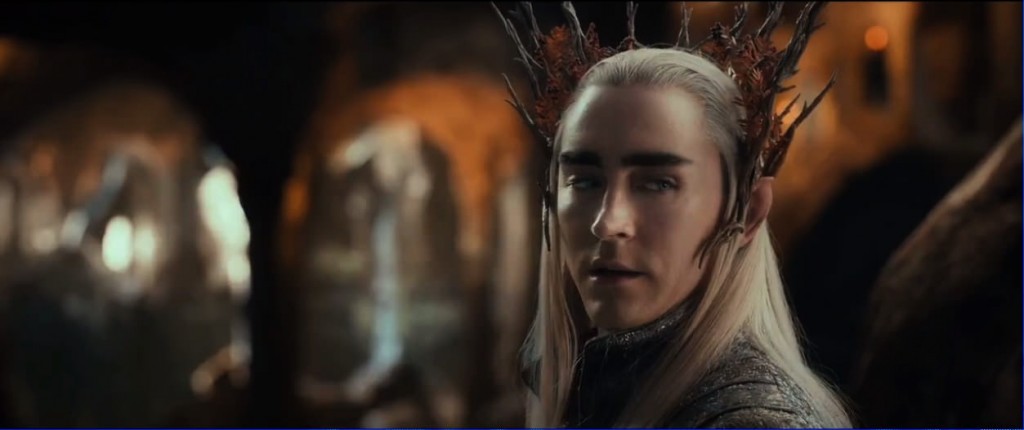 In closing, I just want to cover a few bases I may have missed. One of the best performances of the film is that of Lee Pace as the Elvenking Thranduil. He offers both a pomposity and vulnerability to his character that makes him truly captivating. In a sense, he perfectly captures the Elvenking of Tolkien’s book – but I can’t say I ever felt I understood him the way I do through Pace’s portrayal. Orlando Bloom returns to the role of Legolas, and I think he’s better than ever. Bloom’s increased experience with acting comes to play in this film – and you can really feel his hatred of the dwarves. On the technical side, I much preferred Andrew Lesnie’s cinematography in this film to the last. The color grading here creates a more subdued look, as we head into the darker phase of the story. Peter Jackson’s direction feels more confident here than in An Unexpected Journey – and the editing is reminiscent of The Lord of the Rings theatrical cuts, for better or for worse, with PJ unafraid to fly from one scene to the next to maintain forward momentum. You can tell he’s saving some moments for the Extended Edition – and while I think some moments were perhaps edited too tightly, one can hardly blame him after the reception of the previous film’s more leisurely pace. As mentioned before, Howard Shore’s musical score is extraordinary. He creates an abundance of new themes – with only a few fleeting references to older material. The music for Smaug, though hinted at in the previous score, dominates the later scenes in a way that assaults the senses.
In closing, I just want to cover a few bases I may have missed. One of the best performances of the film is that of Lee Pace as the Elvenking Thranduil. He offers both a pomposity and vulnerability to his character that makes him truly captivating. In a sense, he perfectly captures the Elvenking of Tolkien’s book – but I can’t say I ever felt I understood him the way I do through Pace’s portrayal. Orlando Bloom returns to the role of Legolas, and I think he’s better than ever. Bloom’s increased experience with acting comes to play in this film – and you can really feel his hatred of the dwarves. On the technical side, I much preferred Andrew Lesnie’s cinematography in this film to the last. The color grading here creates a more subdued look, as we head into the darker phase of the story. Peter Jackson’s direction feels more confident here than in An Unexpected Journey – and the editing is reminiscent of The Lord of the Rings theatrical cuts, for better or for worse, with PJ unafraid to fly from one scene to the next to maintain forward momentum. You can tell he’s saving some moments for the Extended Edition – and while I think some moments were perhaps edited too tightly, one can hardly blame him after the reception of the previous film’s more leisurely pace. As mentioned before, Howard Shore’s musical score is extraordinary. He creates an abundance of new themes – with only a few fleeting references to older material. The music for Smaug, though hinted at in the previous score, dominates the later scenes in a way that assaults the senses.
The film finishes on a cliffhanger that has enraged many, but delighted others (yours truly is in the latter category). It comes on the heels of a magnificently executed action set piece (occurring on multiple fronts) that will leave you excited or infuriated (depending on your attachment to the source material) – or maybe even both. For myself, I can only say that I am eagerly anticipating the final film in Peter Jackson’s trilogy – something that I wasn’t saying this time last year. My experience with the first film was one of unmet expectations. I had built up an idea of what PJ’s adaptation of The Hobbit would be – and that film never materialized. I expected it to evoke historical epics more than lighthearted adventure (as The Lord of the Rings had done). I expected something more in keeping, visually and tonally, with the previous trilogy. I spent many of my viewings of An Unexpected Journey waiting for that old nostalgic Rings feeling. But The Hobbit is not The Lord of the Rings – and The Desolation of Smaug takes you along into uncharted territory, filled with wonder and adventure. If you haven’t yet seen the film, see it in 48 FPS and 3D (if you have, see it again), and journey to the Lonely Mountain with Bilbo, Thorin Oakenshield and his company of dwarves.


